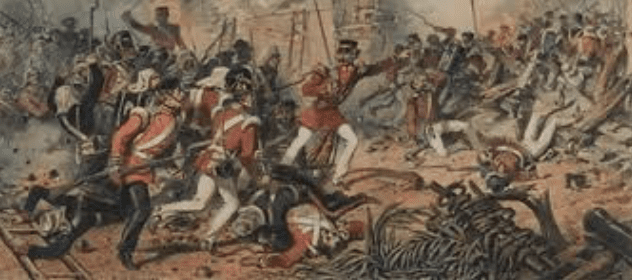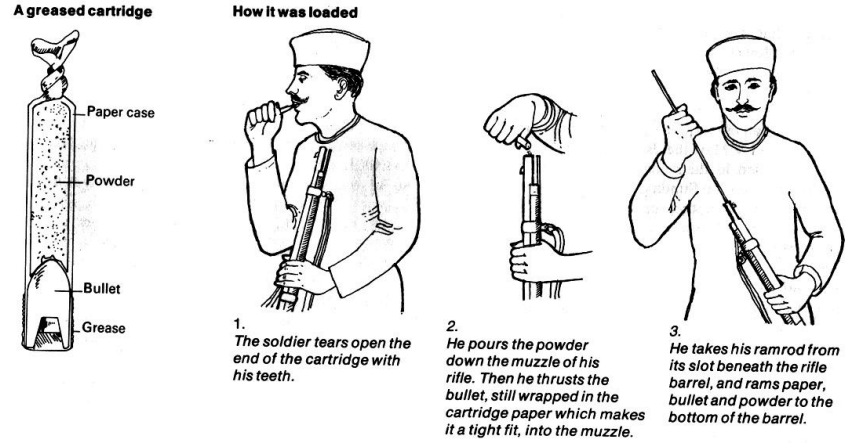PEOPLE’S RESISTANCE TOOK THREE BROAD FORMS:
- CIVIL REBELLIONS,
- TRIBAL UPRISINGS AND
- PEASANT MOVEMENTS.

IMPORTANT REBELLIONS BEFORE 1857
SANYASI/FAKIR REVOLT, BENGAL (1763-1800)
- Ascetics used to exact a religious tax from the headmen and zamindars or regional landlords
- Since the East India Company received the Diwani, the tax demands increased making it difficult for the local landlords and headmen to pay both the ascetics and the English.
- Sanyasis thus raided Company factories and the treasuries and fought the Company’s forces
- Majnum Shah (or Majnu Shah), Chirag Ali, Musa Shah, Bhawani Pathak and Debi Chaudhurani were important leaders
Anandamath, a semi-historical novel by Bankim Chandra Chattopadhyay, is based on the Sanyasi Revolt. Bankim Chandra also wrote a novel, Devi Chaudhurani
POLIGARS’ REVOLT (1795-1805)
- The Poligars of Dindigal and Malabar rose against the oppressive land revenue system under the British during 1801-06.
- The first Polygar War : Tirunelveli District
- Main Leader: Kattabomma Nayak of Panchalamkurichi, later hanged
- The Second Polygar war of 1800- 01 : also known as the “South Indian Rebellion”.
- Polygar armies bombed theBritish barracks in Coimbatore.
Carnatic Treaty on July 31, 1801: British assumed direct control over Tamil Nadu. The Polygar system was violently ended and Zamindari settlement introduced.
PAIKA REBELLION, ODISHA (1817)
- Traditional landed militia (‘foot soldiers’ literally) who enjoyed rent free land tenures for their military service and policing functions on a hereditary basis
- The English Company’s conquest of Odisha in 1803 led to the dethronement of the Raja of Khurda.
- Bakshi Jagabandhu Bidyadhar, the military chief under Raja of Khurda was stripped off his ancestral estate of Killa Rorang
- With support of Mukunda Deva, last Raja of Khurda, Bakshi Jagabandhu Bidyadhar led a sundry army of Paikas forcing the East India Company forces to retreat for a time.
The Paik Rebellion succeeded in getting large remissions of arrears, reductions in assessments, suspension of the sale of the estates of defaulters at discretion, a new settlement on fixed tenures and other adjuncts of a liberal governance.
WAHABI MOVEMENT
- The Wahabi Movement was essentially an Islamic revivalist movement founded by Syed Ahmed of Rai Bareilly who was inspired by the teachings of Abdul Wahab (1703-87) of Saudi Arabia and ShahWaliullah of Delhi.
- After the incorporation of Punjab into the East India Company’s dominion in 1849, the Englishdominion in India became the sole target of the Wahabis’ attacks.
- They spread anti- British sentiments.
A series of military operations by the British in the 1860s on the Wahabi base in Sithana and various court cases of sedition on the Wahabis weakened the Wahabi resistance.
KUKA REVOLT
Started in 1840 by Bhagat Jawahar Mal (also called Sian Saheb) in western Punjab.
- Social reforms: abolition of caste and similar discriminations among Sikhs, discouraging the consumption of meat and alcohol and drugs, permission for intermarriages, widow remarriage, and encouraging women to step out of seclusion.
- Political reforms: the Kukas wanted to remove the British and restore Sikh rule over Punjab; they advocated wearing hand-woven clothes and boycott of English laws and education and products.
PAGAL PANTHIS
- The Pagal Panthi, a semi-religious group mainly constituting the Hajong and Garo tribes of Mymensingh district (earlier in Bengal), was founded by Karam Shah.
- The tribal peasants organise dthemselves to fight the oppression of the zamindars.
- From 1825 to 1835, the Pagal Panthis refused to pay rent above a certain limit
FARAIZI REVOLT
- The Faraizis were the followers of a Muslim sect founded by Haji Shariat-Allah of Faridpur in Eastern Bengal.
- They advocated radical religious, social and political changes.
- Shariat-Allah son of Dadu Mian (1819-60) organised his followers with an aim to expel the English intruders from Bengal.
- The sect also supported the cause of the tenants against the zamindars.
MOPPLAH REBELLION
- The Moplahs were Muslim tenant farmers in the region of Malabar, South India
- Hike in revenue demand and reduction of field size, coupled with the oppression of officials, resulted in widespread peasant unrest among the Moplahs of Malabar.
- Their rebellion was not only directed against British but also the Hindu Landlords.
CHUAR UPRISING
- Chuars were aboriginal tribesmen of the Jungle Mahal of Midnapore district and of the Bankura district (in Bengal)
- Reasons: Famine and enhanced land revenue demands led to economic distress
- This made them take up arms against corrupt officials and British.
KOL MUTINY
- The Kols, along with other tribes were inhabitants of Chhotanagpur.
- This covered Ranchi, Singhbhum, Hazaribagh, Palamau and the western parts of Manbhum.
- The trouble in 1831 started with large-scale transfers of land from Kol headmen to outsiders.
- The Kols resented under the leadership of Buddho Bhagat
HO AND MUNDA UPRISING
- The Raja of Parahat organized his Ho tribals to revolt against the occupation of Singhbhum (now in Jharkhand).
- The revolt continued till 1827 when the Ho tribals were forced tosubmit
- In 1831, they again organized a rebellion, joined by the Mundas of Chotanagpur, to protest against the newly introduced farming revenue policy and the entry of Bengalis into their region.
Khond Uprisings (1837-1856)
The Khonds were tribals who lived in the hilly tracts extending from Odisha to the Srikakulam and Visakhapatnam districts of Andhra Pradesh SANTHAL REBELLION 1885-86.
Main issues
- Attempt by government to suppress human sacrifice (Mariah) The introduction of new taxes by the British
- The influx of Zamindars and sahookars (money-lenders) into their areas which was causing the tribals untold misery.
SANTHAL REBELLION 1885-86
- The Santhals, an agricultural community fled to settle in the plainsof the Rajmahal hills (Bihar) due tocontinuous oppression by the zamindars.
- The rebellion soon turned into an anti-British movement.
- Under Sidhu and Kanhu, twobrothers, the Santhals proclaimed an end to Company rule.
- They declared the area between Bhagalpur and Rajmahal as autonomous.
- A separate district of Santhal Parganas was created by the Government to pacify the Santhals.
BHIL REVOLTS
- The Bhils, who lived in the Western Ghats (former Maratha territories) controlledthe mountain passes between the north and the Deccan.
- They revolted against Company rule in 1817-19, as they had to face famine, economic distress and misgovernment.
RAMOSI RISINGS
- The Ramosis, the hill tribes of the Western Ghats, had not reconciled to British rule and the British pattern of administration.
- They rose under Chittur Singh in 1822 and plundered the country around Satara
KOLI RISINGS
- The Kolis, lived near to the Bhils in Ahmednagar
- They rose up in rebellion against the Company’s rule but were easily crushed.
SEPOY MUTINIES BEFORE 1857
- In 1806, the replacement of the turban by a leather cockade caused a mutiny at Vellore.
- In 1844, there was a mutinous outbreak of the Bengal army sepoys for being sent to far away Sind
- In 1824, the sepoys at Barrackpore rose in revolt when they were asked to go to Burma because crossing the sea would mean loss of caste.
REVOLT OF 1857
THE 1857 REVOLT: THE MAJOR CAUSES
Economic Causes:
- Exploitative colonial policies
- Miserable condition of artisans and decline in handicrafts
- High tariff duties on Indian-made goods crippled trade
- Import of cheap British goods into India
- Free Trade and refusal to impose protective duties against machine-made goods from Britain
- Zamindars, the traditional landed aristocracy, often saw their land rights forfeited with frequent use of a quo warranto by the administration.
Socio-Religious Causes
- Racial overtones and a superiority complex characterized the British administrative attitude towards the native Indian population
- The government’s decision to tax mosque and temple lands and making laws such as the Religious Disabilities Act, 1856
DISCONTENT AMONG SEPOYS
- The conditions of service in the Company’s Army and cantonments increasingly came into conflict with the religious beliefs and prejudices of the sepoys.
- In 1856, Lord Canning’s government passed the General Service Enlistment Act which decreed that all future recruits to the Bengal Army would have to give an undertaking to serve anywhere their services might be required by the government. This caused resentment.
- Immediate cause of the sepoys’ dissatisfaction was the order that they would not be given the foreign service allowance (bhatta) when serving in Sindh or in Punjab.
GROWING DISCONTENT
- Mixing of bone dust in atta (flour)
- Introduction of the Enfield rifle enhanced the sepoys (The greased wrapping paper of the cartridge had to be bitten off before loading which reportedly made of beef and pig fat)

BEGINNINGS AT MEERUT
- Sepoy of the 34th Native Infantry, Mangal Pande, went a step further and fired at the sergeant major of his unit at Barrackpore.
- The revolt began at Meerut, on May 10, 1857
ALTERNATE TO BRITISH: THE MUGHAL BANNER
- This spontaneous raising of the last Mughal king to the leadership of the country was a recognition of the fact that the long reign of Mughal dynasty had become the traditional symbol of India’s political unity.
- The entire Bengal Army soon rose in revolt which spread quickly.
- Awadh, Rohilkhand, the Doab, Bundelkhand, central India, large parts of Bihar and East Punjab shook off British authority.
- The revolt of the sepoys was accompanied by a rebellion of the civil population, particularly in the north-western provinces and Awadh.
- The peasants and petty zamindars took advantage of the revolt to destroy the money-lenders’ account books and debt records.
STORM CENTRES AND LEADERS OF THE REVOLT
- Delhi: General Bakht Khan
- Kanpur: Nana Saheb proclaimed himself the peshwa, acknowledged Bahadur Shah as the Emperor of India and declared himself to be his governor.
- Lucknow: Begum Hazrat Mahal
- Bareilly: Khan Bahadur, a descendant of the former ruler of Rohilkhand
- Bihar: Kunwar Singh, the zamindar of Jagdishpur.
- Faizabad: Maulvi Ahmadullah
- Jhansi: Rani Laxmibai (The Rani of Jhansi and Tantia Tope marched towards Gwalior)
- Baraut (Baghpat, Uttar Pradesh): Shah Mal, a local villager organised the headmen and peasants of 84 villages (referred as chaurasi desh). Shah Mal’s body was cut into pieces and his head displayed on July 21, 1857 by the British.
ASSESSMENT OF THE REVOLT
- All-India participation was absent.
- Rulers who did not participate included the Sindhia of Gwalior, the Holkar of Indore, the rulers of Patiala, Sindh and other Sikh chieftains and the Maharaja of Kashmir.
- Many zamindars and educated middle class kept away.
- Poor Arms and Equipment
- Uncoordinated and Poorly Organized
- Positive: Hindu-Muslim Unity Factor
AFTERMATH
- The British Parliament, on August 2, 1858, passed an Act for the Better Government of India which declared Queen Victoria as the sovereign of British India and provided for the appointment of a Secretary of State for India
- The assumption of the Government of India by the sovereign of Great Britain was announced by Lord Canning at a durbar at Allahabad in the ‘Queen’s Proclamation’ issued on November 1, 1858.
- The proclamation also promised equal and impartial protection under law to all Indians, besides equal opportunities in government services irrespective of race or creed.
- It was also promised that old Indian rights, customs and practices would be given due regard while framing and administering the law.
- The Army Amalgamation Scheme, 1861 moved the Company’s European troops to the services of the Crown.